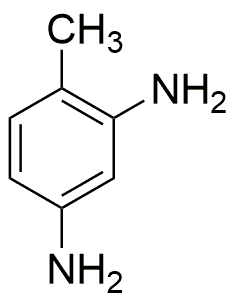2,4-Diaminotoluene is widely utilized in research focused on:
- Polyurethane Production: This compound serves as a key intermediate in the synthesis of polyurethane foams, which are used in furniture, insulation, and automotive applications due to their excellent durability and insulation properties.
- Dyes and Pigments: It is a vital ingredient in the production of azo dyes, which are widely used in textiles and printing. These dyes offer vibrant colors and good lightfastness, making them popular in the fashion industry.
- Pharmaceuticals: 2,4-Diaminotoluene is used in the synthesis of various pharmaceutical compounds, particularly in the development of anti-cancer drugs. Its ability to modify biological activity makes it valuable in medicinal chemistry.
- Explosives: This chemical is involved in the formulation of certain explosives, providing stability and enhancing performance. Its application in the defense industry is crucial for developing safer and more effective munitions.
- Adhesives and Sealants: The compound is also utilized in formulating high-performance adhesives and sealants, which are essential in construction and automotive industries for their strong bonding capabilities and resistance to environmental factors.
General Information
Properties
Safety and Regulations
Applications
2,4-Diaminotoluene is widely utilized in research focused on:
- Polyurethane Production: This compound serves as a key intermediate in the synthesis of polyurethane foams, which are used in furniture, insulation, and automotive applications due to their excellent durability and insulation properties.
- Dyes and Pigments: It is a vital ingredient in the production of azo dyes, which are widely used in textiles and printing. These dyes offer vibrant colors and good lightfastness, making them popular in the fashion industry.
- Pharmaceuticals: 2,4-Diaminotoluene is used in the synthesis of various pharmaceutical compounds, particularly in the development of anti-cancer drugs. Its ability to modify biological activity makes it valuable in medicinal chemistry.
- Explosives: This chemical is involved in the formulation of certain explosives, providing stability and enhancing performance. Its application in the defense industry is crucial for developing safer and more effective munitions.
- Adhesives and Sealants: The compound is also utilized in formulating high-performance adhesives and sealants, which are essential in construction and automotive industries for their strong bonding capabilities and resistance to environmental factors.
Documents
Safety Data Sheets (SDS)
The SDS provides comprehensive safety information on handling, storage, and disposal of the product.
Product Specification (PS)
The PS provides a comprehensive breakdown of the product’s properties, including chemical composition, physical state, purity, and storage requirements. It also details acceptable quality ranges and the product's intended applications.
Certificates of Analysis (COA)
Search for Certificates of Analysis (COA) by entering the products Lot Number. Lot and Batch Numbers can be found on a product’s label following the words ‘Lot’ or ‘Batch’.
*Catalog Number
*Lot Number
Certificates Of Origin (COO)
This COO confirms the country where the product was manufactured, and also details the materials and components used in it and whether it is derived from natural, synthetic, or other specific sources. This certificate may be required for customs, trade, and regulatory compliance.
*Catalog Number
*Lot Number
Safety Data Sheets (SDS)
The SDS provides comprehensive safety information on handling, storage, and disposal of the product.
DownloadProduct Specification (PS)
The PS provides a comprehensive breakdown of the product’s properties, including chemical composition, physical state, purity, and storage requirements. It also details acceptable quality ranges and the product's intended applications.
DownloadCertificates of Analysis (COA)
Search for Certificates of Analysis (COA) by entering the products Lot Number. Lot and Batch Numbers can be found on a product’s label following the words ‘Lot’ or ‘Batch’.
*Catalog Number
*Lot Number
Certificates Of Origin (COO)
This COO confirms the country where the product was manufactured, and also details the materials and components used in it and whether it is derived from natural, synthetic, or other specific sources. This certificate may be required for customs, trade, and regulatory compliance.


